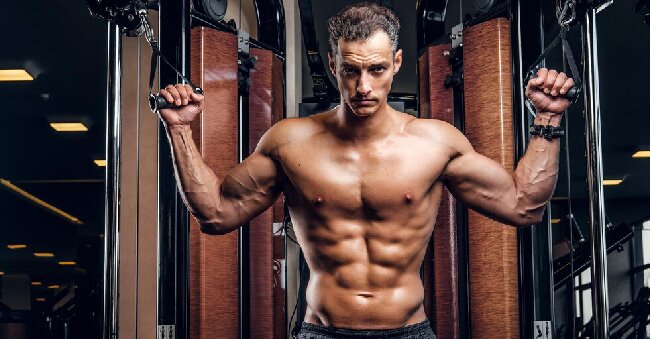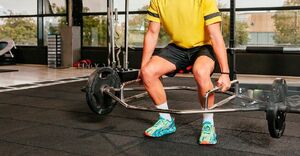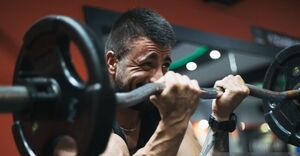
Mastering Plate-Loaded Chest Fly Machines: Techniques and Workouts
Enhance your chest workouts and target specific muscles like the pectoralis major, deltoids, and biceps with a plate-loaded chest fly machine.
We’ll explore how this machine works, the muscles it targets, the benefits of using it, common techniques for proper form, effective workouts to try, and tips for mastering it.
Whether you’re a beginner or a seasoned gym-goer, there’s something here for everyone looking to up their chest workout game.
What Is a Plate-Loaded Chest Fly Machine?
A Plate-Loaded Chest Fly Machine is a specialized gym equipment designed to target the pectoral muscles and enhance upper body strength through a controlled range of motion.
This machine functions by allowing users to perform a horizontal fly motion, mimicking the action of bringing arms together in front of the chest. By adjusting the weight plates according to individual strength levels, users can progressively challenge their muscles for growth and development. Plate-loaded chest fly machines are particularly beneficial for fitness enthusiasts looking to sculpt their chest muscles effectively. Regularly incorporating this equipment into a workout routine can help improve muscle definition, enhance chest aesthetics, and improve overall upper body strength.
How Does a Plate-Loaded Chest Fly Machine Work?
Plate-Loaded Chest Fly Machines operate by allowing users to move weight plates along a guided path, controlling the range of motion to isolate and engage the chest muscles effectively.
These machines typically feature adjustable handles or arms that users can grip to perform the chest fly movement. By adjusting the weight plates on the machine, individuals can modify the resistance to match their strength levels and fitness goals. It is crucial for users to maintain proper form throughout the exercise, ensuring that they control the movement to prevent any jerky or swinging motions. By optimizing the range of motion, individuals can target specific areas of the chest, such as the pectoralis major and minor, for maximum muscle activation and growth.
What Muscles Does a Plate-Loaded Chest Fly Machine Target?
A Plate-Loaded Chest Fly Machine primarily targets the pectoralis major muscles while engaging the deltoids and biceps to strengthen and tone the upper body.
This exercise is particularly effective for isolating the chest muscles, helping to enhance definition and size in the pectorals. As you execute the fly motion on the machine, the pectoralis major muscles are fully engaged, working to bring the arms together against the resistance. The movement also recruits the deltoids, which assist in stabilizing the shoulder joint during the exercise. The biceps are activated as secondary muscles, further contributing to the overall development of the upper body. Regular incorporation of Plate-Loaded Chest Fly Machine workouts into your routine can lead to significant improvements in chest strength and muscle growth.
Pectoralis Major
The Pectoralis Major, commonly known as the chest muscles, is the primary muscle group engaged when using a Plate-Loaded Chest Fly Machine, aiding in chest development and strength.
Chest fly exercises are particularly effective in isolating and targeting the Pectoralis Major, as they involve a wide range of motion which helps to stretch and contract the muscle fibers effectively. By focusing on this muscle group during chest workouts, individuals can improve not only the appearance of their chest but also enhance overall upper body strength and stability. Strengthening the Pectoralis Major can also contribute to better posture and shoulder stability, making it essential for a well-rounded fitness routine.
Deltoids
The Deltoids, or shoulder muscles, play a supporting role during Plate-Loaded Chest Fly Machine workouts, assisting in stabilizing the shoulder joints and contributing to upper body strength.
The Deltoids are particularly engaged during chest fly exercises due to their crucial function in shoulder stability. As you perform the fly motion, the Deltoids work to control the movement of the shoulder joint, ensuring smooth and controlled action. This engagement of the Deltoids not only enhances the effectiveness of the exercise but also helps in building strength and definition in the upper body.
By incorporating chest fly exercises into your workout routine, you can effectively target and develop the Deltoids along with other major upper body muscles.
Biceps
The Biceps, located in the front of the upper arms, are activated as secondary muscles during Plate-Loaded Chest Fly Machine movements, providing additional support and assistance.
Engaging the biceps in chest fly exercises not only aids in stabilizing the movement but also plays a crucial role in enhancing overall upper body strength. By assisting the primary muscles targeted in the chest fly, such as the pectoralis major, the biceps contribute to a more coordinated and effective workout. This dual involvement of the biceps not only leads to better muscle engagement but also helps in developing a well-rounded upper body physique. The activation of the biceps in chest fly exercises can lead to improved muscle endurance and functional strength.
What Are the Benefits of Using a Plate-Loaded Chest Fly Machine?
Using a Plate-Loaded Chest Fly Machine offers benefits such as a full range of motion, muscle isolation, and customizable resistance levels for targeted upper body strengthening.
Incorporating this machine into your workout routine can lead to enhanced muscle activation in the chest, shoulders, and arms. The controlled movements of the Chest Fly Machine help prevent injury by maintaining proper form throughout the exercise. The ability to adjust the resistance levels allows for progressive overload, ensuring continuous muscle growth and strength development. With its focus on the pectoral muscles, this machine provides a tailored workout experience that maximizes results for individuals looking to sculpt and tone their upper body.
Full Range of Motion
One key benefit of using a Plate-Loaded Chest Fly Machine is the ability to achieve a full range of motion during chest exercises, ensuring optimal muscle engagement and development.
This enhanced range of motion plays a vital role in effectively stretching and contracting the chest muscles throughout the entire exercise. By allowing the chest to move through its full range, individuals can experience improved muscle flexibility and adaptability.
Incorporating a full range of motion in chest fly workouts not only helps in maximizing muscle recruitment for strength gains but also contributes to enhancing overall upper body mobility. Emphasizing proper form and technique to execute a complete range of motion can lead to more profound muscle activation and long-term fitness benefits.
Isolation of Muscles
Plate-Loaded Chest Fly Machines enable precise muscle isolation, facilitating targeted activation of the pectoral muscles without excessive strain on supporting muscle groups.
This targeted activation plays a crucial role in efficient strength training and muscle development. By isolating the pectoral muscles, individuals can effectively work on enhancing muscle definition and size in this specific area.
This focused approach helps in avoiding the recruitment of secondary muscles, allowing the primary muscles to be thoroughly engaged and stimulated. As a result, users can experience significant improvements in their chest strength and overall muscle balance.
Incorporating Plate-Loaded Chest Fly Machines into a workout routine can lead to enhanced muscle growth and better performance in various upper body exercises.
Customizable Resistance
The customizable resistance levels of Plate-Loaded Chest Fly Machines allow users to adjust weight settings according to their strength levels and training goals, promoting progressive muscle strengthening.
This ability to customize the resistance on these machines can have a profound impact on the effectiveness of chest fly workouts. By being able to vary the weights used, individuals are able to stimulate different muscle fibers and promote muscle adaptation.
This variation in resistance not only helps in achieving strength gains but also plays a crucial role in avoiding plateaus in fitness progress. Emphasizing progressive overload through adjusting resistance levels can lead to continuous improvements in muscle strength and overall fitness levels.
What Are Some Common Techniques for Using a Plate-Loaded Chest Fly Machine?
Mastering the Plate-Loaded Chest Fly Machine involves adopting proper form, precise technique, and maintaining control throughout each repetition to maximize muscle engagement and performance.
- One crucial aspect to focus on when using this machine is ensuring that your back is flat against the bench and your feet are firmly planted on the ground to provide a stable base. This will help in stabilizing your body and preventing unnecessary strain on your lower back.
- It’s essential to keep your shoulders relaxed and avoid shrugging them during the movement. Concentrate on a slow and controlled motion, feeling the stretch in your chest muscles as you bring the handles together.
- Remember to exhale as you push the handles back out to the starting position, engaging your chest muscles fully.
Proper Form and Posture
Maintaining proper form and posture is essential when using a Plate-Loaded Chest Fly Machine to prevent injuries, optimize muscle activation, and ensure effective workout outcomes.
Proper alignment during chest fly exercises helps to distribute the load evenly across the muscles, reducing the risk of strains or imbalances. By focusing on posture stability, individuals can target the chest muscles more efficiently and minimize the involvement of secondary muscles.
Correcting form issues such as excessive arching of the back or flaring of the elbows is crucial for injury prevention and to fully engage the target muscles. Paying attention to these details can also enhance the overall effectiveness of the workout and lead to greater strength gains over time.
Controlled Movement
Executing controlled movements while using a Plate-Loaded Chest Fly Machine enhances muscle contraction, coordination, and strength development, emphasizing the quality of each repetition over quantity.
Precision in movement execution during chest fly workouts plays a crucial role in activating the targeted chest muscles effectively. By maintaining proper form and control throughout the exercise, individuals can ensure that the muscles are properly engaged, leading to improved muscle coordination and overall strength gains.
Controlling the tempo of each repetition not only enhances the mind-muscle connection but also helps in maximizing the effectiveness of the workout by minimizing momentum reliance and focusing on muscle contraction. This intentional approach to movement not only stimulates muscle growth but also reduces the risk of injury by promoting proper muscle activation.
Breathing Techniques
Incorporating proper breathing techniques during Plate-Loaded Chest Fly Machine exercises helps maintain intra-abdominal pressure, stabilize the core, and optimize oxygen flow for enhanced workout performance.
By focusing on your breath, you can ensure that your core remains engaged throughout each repetition, providing crucial support to your spine and protecting against potential injuries. Proper breathing patterns also aid in maximizing oxygenation to your muscles, allowing for greater endurance and efficiency during the exercise. Remember, a controlled and mindful breath can make all the difference in how effectively you engage your chest muscles and get the most out of your workout.
What Are Some Effective Workouts Using a Plate-Loaded Chest Fly Machine?
Implementing various workout strategies such as pyramid sets, drop sets, supersets, circuit training, and progressive overload techniques can enhance the effectiveness of Plate-Loaded Chest Fly Machine routines.
These different approaches not only add excitement and variability to your training but also target your chest muscles in unique ways, promoting overall muscle development. By incorporating pyramid sets, you can gradually increase the weight with each set, challenging your muscles at different intensities. Drop sets help exhaust your chest muscles by decreasing the weight as you reach muscle failure, pushing you to your limits. Supersets and circuit training keep your heart rate elevated, facilitating calorie burn and improving cardiovascular fitness alongside muscle growth. Progressively overloading the weights ensures continual muscle adaptation and growth over time.
Pyramid Sets
Pyramid sets involve gradually increasing weight or repetitions in each set while using Plate-Loaded Chest Fly Machines, promoting muscle endurance, strength gains, and workout progression.
This method allows individuals to challenge their muscles in a structured manner, starting with lighter weights or fewer reps to warm up the muscles and progressively increasing the intensity as they advance through each set.
The gradual increment helps in maximizing muscle recruitment and fatigue, leading to enhanced muscle growth and overall strength improvement.
By adjusting the weight or repetitions after each set, pyramid sets provide a balanced approach to muscle adaptation, avoiding plateaus and continuously pushing the body to adapt and grow.
Drop Sets
Drop sets involve reducing weight after reaching muscle fatigue during Plate-Loaded Chest Fly Machine exercises, allowing for extended repetitions, increased muscle pump, and metabolic stress for muscle growth.
This technique of drop sets in chest fly workouts is not only effective for pushing past plateaus but also contributes to enhancing muscle endurance and strength. By incorporating drop sets, you challenge the muscle fibers to adapt to varying intensities, promoting continuous growth and development.
The systematic reduction in weight enables you to extend the time under tension, maximizing the recruitment of muscle fibers and fostering greater metabolic stimulation. This process aids in breaking down muscle tissues effectively, ensuring comprehensive muscle engagement and diverse muscle fiber activation for overall chest development.
Supersets
Supersets involve performing two exercises back-to-back with minimal rest using Plate-Loaded Chest Fly Machines, enhancing muscle activation, workout efficiency, and time-saving benefits.
This method is particularly effective for chest fly routines as it allows for continuous muscle engagement throughout the superset. By transitioning directly from one exercise to another, the chest muscles are constantly under tension, promoting increased muscle fiber recruitment and stimulation. This not only aids in building strength and muscle mass but also contributes to a more effective workout by minimizing rest periods.
Utilizing supersets in chest fly routines can help reduce overall fatigue compared to traditional sets, as the muscles receive brief breaks during alternating movements, allowing for better endurance and performance. The optimization of training volume achieved through supersets can result in improved muscle growth and overall fitness development.
Circuit Training
Circuit training incorporating Plate-Loaded Chest Fly Machines combines multiple exercises in a structured routine, promoting cardiovascular fitness, muscle conditioning, and workout variability.
This type of training is highly effective due to its ability to target different muscle groups within one session, allowing for a comprehensive workout experience. By incorporating chest fly exercises into a circuit, individuals can strengthen their chest, shoulders, and arms while also engaging their core for stabilization. Varying the movements and adjusting the repetition ranges ensures that muscles are constantly challenged and prevents plateauing. Strategically sequencing exercises boosts overall physical conditioning and training efficiency, leading to improved strength, endurance, and muscle tone.
Progressive Overload
Progressive overload techniques with Plate-Loaded Chest Fly Machines involve gradually increasing resistance levels to continually challenge the muscles, stimulate growth, and promote strength gains.
By progressively challenging the muscles through higher resistance, individuals can create micro-tears in the muscle fibers, prompting the body to repair and rebuild stronger muscles.
Adapting weightlifting techniques such as adjusting the range of motion or time under tension during chest fly exercises can further enhance muscle activation and development.
Consistently tracking performance improvements, such as increased weight lifted or additional repetitions completed, is key to ensuring steady progress and avoiding plateaus in muscle growth and overall fitness.
This emphasis on progressive overload in chest fly workouts is fundamental for sustained muscle development and continuous improvement.
What Are Some Tips for Mastering the Plate-Loaded Chest Fly Machine?
Mastering the Plate-Loaded Chest Fly Machine requires starting with light weights, focusing on form and control, and incorporating training variations for progressive skill development and muscle growth.
Gradual progression is key when using the Plate-Loaded Chest Fly Machine. Begin by selecting a weight that allows you to perform the exercise with proper form and control. Focus on the full range of motion, ensuring that your chest muscles are fully engaged throughout the movement. As you become more comfortable with the exercise, gradually increase the resistance to continue challenging your muscles. Remember, quality over quantity is essential.
Incorporating different variations such as adjusting the incline or the grip width can help target different areas of the chest and prevent plateauing in your workout routine.
Start with Light Weights
Commencing your Plate-Loaded Chest Fly Machine sessions with lighter weights allows for proper warm-up, muscle activation, and technique reinforcement before progressing to heavier resistance levels.
Light weights help activate and engage the chest muscles gradually, reducing the risk of injury and enabling the body to acclimate to the exercise movements. By starting with a weight that is manageable, you can focus on refining your form and strengthening the mind-muscle connection.
These warm-up sets also aid in increasing blood flow to the targeted muscle groups, priming them for the more intense sets to come. Over time, this approach builds a solid foundation for improved strength and endurance gains in your chest fly workouts.
Focus on Form and Control
Emphasizing proper form and control throughout your Plate-Loaded Chest Fly Machine exercises enhances muscle engagement, reduces injury risks, and optimizes the effectiveness of each repetition.
Correct technique is key in ensuring that you target the intended muscle groups effectively during chest fly movements. By maintaining a stable posture and controlling the range of motion, you can activate the chest muscles more efficiently. Precision in your movements not only reduces the chance of strains or imbalances but also leads to improved performance outcomes. Focusing on form allows you to make the most out of each rep, promoting muscle growth and strength development over time.
Incorporate Variations and Progression
Integrating workout variations and progression schemes into your Plate-Loaded Chest Fly Machine routines challenges the muscles, prevents plateaus, and promotes continuous muscle development and growth.
By introducing diverse training techniques such as varying the angle of the bench, adjusting the weight, or altering the tempo, your body is constantly forced to adapt, resulting in enhanced muscle activation and overall strength gains. This approach not only keeps your workouts engaging and exciting but also targets different muscle fibers, ensuring a well-rounded chest development. This muscle confusion technique can further optimize your performance, prevent overuse injuries, and expedite your fitness progress by challenging your body in new ways.




No Comments